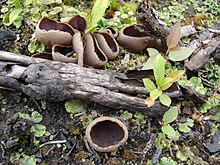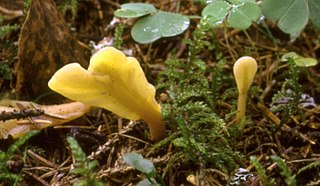
Spathularia flavida, commonly known as the yellow earth tongue, the yellow fan, or the fairy fan, is an ascomycete fungus found in coniferous forests of Asia, Europe and North America. It produces a small, fan- or spoon-shaped fruit body with a flat, wavy or lobed cream to yellow colored "head" raised on a white to cream stalk. The height is usually approximately 2–5 cm, and up to 8 cm. The fungus fruits on the ground in mosses, forest duff or humus, and fruit bodies may occur singly, in large groups, or in fairy rings. The spores produced by the fungus are needle-like, and up to 95 micrometres long. Several varieties have been described that differ largely in their microscopic characteristics. S. flavida has been described by authorities variously as inedible, of unknown edibility, or edible but tough.
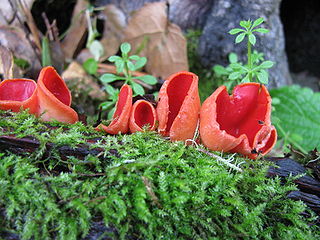
Sarcoscypha coccinea, commonly known as the scarlet elf cup, scarlet elf cap, or the scarlet cup, is a species of fungus in the family Sarcoscyphaceae of the order Pezizales. The fungus, widely distributed in the Northern Hemisphere, has been found in Africa, Asia, Europe, North and South America, and Australia. The type species of the genus Sarcoscypha, S. coccinea has been known by many names since its first appearance in the scientific literature in 1772. Phylogenetic analysis shows the species to be most closely related to other Sarcoscypha species that contain numerous small oil droplets in their spores, such as the North Atlantic island species S. macaronesica. Due to similar physical appearances and sometimes overlapping distributions, S. coccinea has often been confused with S. occidentalis, S. austriaca, and S. dudleyi.

Gyromitra infula, commonly known as the hooded false morel or the elfin saddle, is a fungus in the family Helvellaceae. The dark reddish-brown caps of the fruit bodies develop a characteristic saddle-shape in maturity, and the ends of both saddle lobes are drawn out to sharp tips that project above the level of the fruit body. The stipe is white or flushed pale brown, smooth on the outside, but hollow with some chambers inside. It is found in the Northern Hemisphere, usually in the late summer and autumn, growing on rotting wood or on hard packed ground. G. infula is considered inedible as it contains the toxic compound gyromitrin which, when metabolized by the body, is converted into monomethylhydrazine, a component of some rocket fuels. The toxin may be removed by thorough cooking. Gyromitra fungi are included in the informal category "false morels".
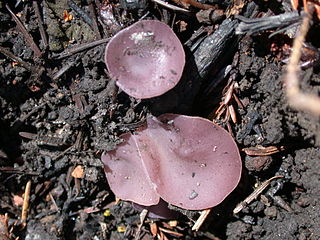
Peziza violacea, commonly known as the violet fairy cup or the violet cup fungus, is a species of fungus in the genus Peziza of the family Pezizaceae. As both it common names and specific epithet suggest, the cup-shaped fruiting bodies are violet colored on the interior surface. P. violacea is typically found growing on burnt soil.
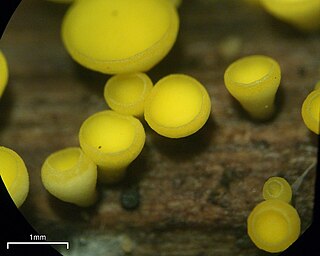
Bisporella citrina, commonly known as yellow fairy cups or lemon discos, is a species of fungus in the family Helotiaceae. The fungus produces tiny yellow cups up to 3 mm in diameter, often without stalks, that fruit in groups or dense clusters on decaying deciduous wood that has lost its bark. The widely distributed species is found in North Africa, Asia, Europe, North America, and Central and South America. Found in late summer and autumn, the fungus is fairly common, but is easily overlooked owing to its small size. There are several similar species that can in most cases be distinguished by differences in color, morphology, or substrate. Microscopically, B. citrina can be distinguished from these lookalikes by its elliptical spores, which have a central partition, and an oil drop at each end.

Geopyxis carbonaria is a species of fungus in the genus Geopyxis, family Pyronemataceae. First described to science in 1805, and given its current name in 1889, the species is commonly known as the charcoal loving elf-cup, dwarf acorn cup, stalked bonfire cup, or pixie cup. The small, goblet-shaped fruitbodies of the fungus are reddish-brown with a whitish fringe and measure up to 2 cm across. They have a short, tapered stalk. Fruitbodies are commonly found on soil where brush has recently been burned, sometimes in great numbers. The fungus is distributed throughout many temperate regions of the Northern Hemisphere. It is found in Europe, Turkey, and North America. Although it is primarily a saprotrophic species, feeding on the decomposing organic matter remaining after a fire, it also forms biotrophic associations with the roots of Norway spruce.

Chorioactis is a genus of fungi that contains the single species Chorioactis geaster. The mushroom is commonly known as the devil's cigar or the Texas star in the United States, while in Japan it is called kirinomitake (キリノミタケ). This extremely rare mushroom is notable for its unusual appearance and disjunct distribution; it is found only in select locales in Texas and Japan. The fruit body, which grows on the stumps or dead roots of cedar elms or dead oaks, somewhat resembles a dark brown or black cigar before it splits open radially into a starlike arrangement of four to seven leathery rays. The interior surface of the fruit body bears the spore-bearing tissue known as the hymenium, and is colored white to brown, depending on its age. The fruit body opening can be accompanied by a distinct hissing sound and the release of a smoky cloud of spores.

Helvella acetabulum is a species of fungus in the family Helvellaceae, order Pezizales. This relatively large cup-shaped fungus is characterized by a tan fruit body with prominent branching ribs resembling a cabbage leaf; for this reason it is commonly known as the cabbage leaf Helvella. Other colloquial names include the vinegar cup and the brown ribbed elfin cup. The fruit bodies reaches dimensions of 8 cm (3.1 in) by 4 cm (1.6 in) tall. It is found in Asia, Europe, and North America, where it grows in sandy soils, under both coniferous and deciduous trees.
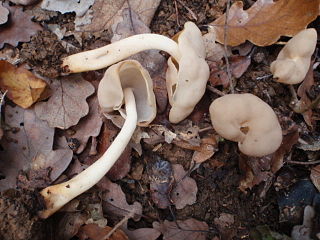
Helvella elastica, commonly known as the flexible Helvella, or the elastic saddle, is a species of fungus in the family Helvellaceae of the order Pezizales. It is found in Asia, Europe, and North America. It has a roughly saddle-shaped yellow-brown cap atop a whitish stipe, and grows on soil in woods. Another colloquial name is the brown elfin saddle.
Korfiella is a fungal genus in the family Sarcosomataceae. A monotypic genus, it contains the single species Korfiella karnika, found in India and described as new to science in 1970.

Sarcosphaera is a fungal genus within the Pezizaceae family. It is a monotypic genus, containing the single species Sarcosphaera coronaria, commonly known as the pink crown, the violet crown-cup, or the violet star cup. It is a whitish or grayish cup fungus, distinguished by the manner in which the cup splits into lobes from the top downward. It is commonly found in the mountains in coniferous woods under humus on the forest floor, and often appears after the snow melts in late spring and early summer. The fungus is widespread, and has been collected in Europe, Israel and the Asian part of Turkey, North Africa, and North America. In Europe, it is considered a threatened species in 14 countries. Although several taxa have been described as Sarcosphaera species since the introduction of the genus in 1869, most lack modern descriptions, have been transferred to the related genus Peziza, or are considered synonymous with S. coronaria.

Pseudoplectania nigrella, commonly known as the ebony cup, the black false plectania, or the hairy black cup, is a species of fungus in the family Sarcosomataceae. The fruit bodies of this saprobic fungus are small blackish cups, typically up to 2 cm (0.8 in) broad, that grow in groups on soil, often amongst pine needles and short grass near coniferous trees. Pseudoplectania nigrella has a worldwide distribution, and has been found in North America, the Caribbean, Britain, Europe, India, Madagascar, New Zealand, and Japan. The fungus produces a unique chemical compound, plectasin, that has attracted research interest for its ability to inhibit the growth of the common human pathogenic bacterium Streptococcus pneumoniae.
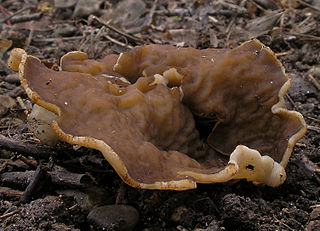
Disciotis venosa, commonly known as the bleach cup, veiny cup fungus, or the cup morel is a species of fungus in the family Morchellaceae. Fruiting in April and May, they are often difficult to locate because of their nondescript brown color. Found in North America and Europe, they appear to favor banks and slopes and sheltered sites. Although D. venosa is edible, it may resemble several other species of brown cup fungi of unknown edibility.

Plectania nannfeldtii, commonly known as Nannfeldt's Plectania, the black felt cup, or the black snowbank cup fungus, is a species of fungus in the family Sarcosomataceae. The fruit bodies of this species resemble small, black, goblet-shaped shallow cups up to 3 cm wide, with stems up to 4 cm long attached to black mycelia. Fruit bodies, which may appear alone or in groups on the ground in conifer duff, are usually attached to buried woody debris, and are commonly associated with melting snow. Plectania nannfeldtii is found in western North America and in Asia, often at higher elevations. Similar black cup fungi with which P. nannfeldtii may be confused include Pseudoplectania vogesiaca, P. nigrella, and Helvella corium.
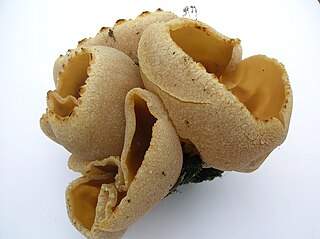
Peziza cerea, commonly known as the Cellar Cup is a species of ascomycete fungus in the genus Peziza, family Pezizaceae. In common with other ascomycetes the upper surface of the fungus has a layer of cylindrical spore producing cells called asci, from which the ascospores are forcibly discharged.

Galiella rufa, commonly known as the rubber cup, the rufous rubber cup, or the hairy rubber cup, is a species of fungus in the family Sarcosomataceae. The fungus produces cup-shaped fruit bodies that typically grow in clusters on branches and exposed portions of buried wood throughout eastern and Midwest North America and in Malaysia. The fruit bodies have the texture of tough, gelatinous rubber, and have a rough, blackish-brown, felt-like outer surface and a smooth reddish-brown inner surface. Although generally considered inedible by North American mushroom field guides, it is commonly consumed in Malaysia. The fungus produces several interesting natural products.
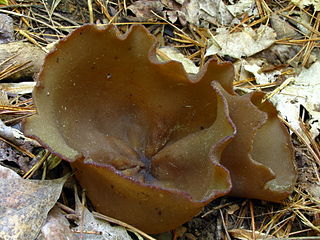
Peziza phyllogena, commonly known as the common brown cup or the pig-ear cup, is a species of fungus in the family Pezizaceae. A saprobic species, the fungus produces brownish, cup-shaped fruit bodies that grow singly or in clusters on either soil or well-rotted wood. It is found in Europe, North America, and Iceland, where it fruits in the spring.

Peziza domiciliana, commonly known as the domicile cup fungus, is a species of fungus in the genus Peziza, family Pezizaceae. Described by English mycologist Mordecai Cubitt Cooke, the fungus grows on rotten wood, drywall/plasterboard, and plaster in homes, damp cellars, and basements. It is known from Asia, Europe, North America, and Antarctica.

Peziza varia, commonly known as the Palomino cup or recurved cup, is a species of fungus in the genus Peziza, family Pezizaceae.

Peziza fimeti is a species of ascomycete fungus belonging to the family Pezizaceae. Found in Europe and North America, the fungus grows on cow dung. It produces small, light brown, cup-shaped fruit bodies up to 2 cm (0.8 in) in diameter. The asci are cylindrical, with dimensions of up to 280 µm long and 18 µm in diameter. The spores are ellipsoid and measure 8 by 16 µm.
